English Heritage sites near Lastingham Parish
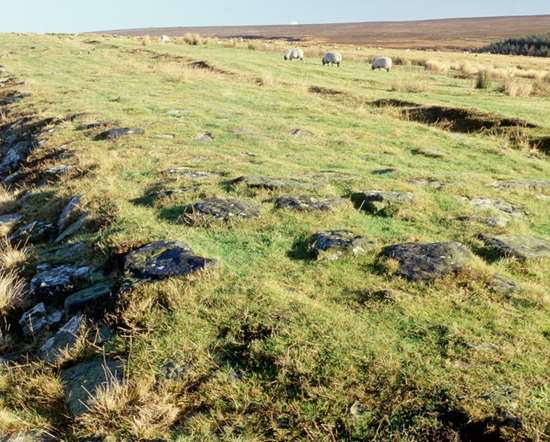
WHEELDALE ROMAN ROAD
5 miles from Lastingham Parish
A mile-long stretch of enigmatic ancient road - probably Roman but possibly later or earlier - amid wild and beautiful moorland, still with its hard core and drainage ditches.
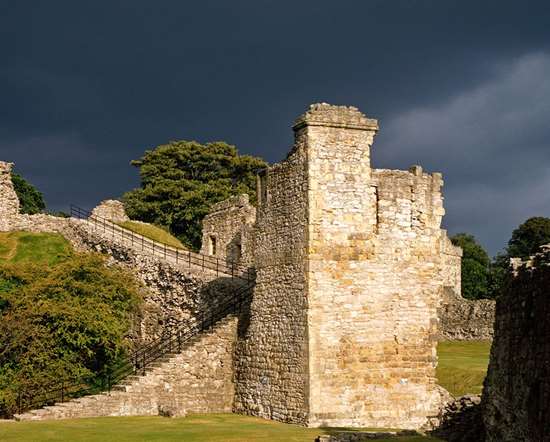
PICKERING CASTLE
6 miles from Lastingham Parish
This splendid 13th century castle was used as a royal hunting lodge, holiday home and stud farm by a succession of medieval kings.
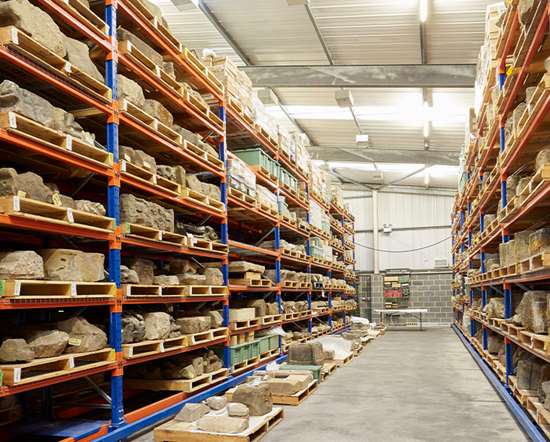
HELMSLEY ARCHAEOLOGY STORE
9 miles from Lastingham Parish
Helmsley Archaeology Store holds the extensive archaeological collections and paper based archives from English Heritage guardianship sites from the North of England including the counties of Northumberland, County Durham, Cumbria, Lancashire, Yorkshire, North Lincolnshire, Cheshire.
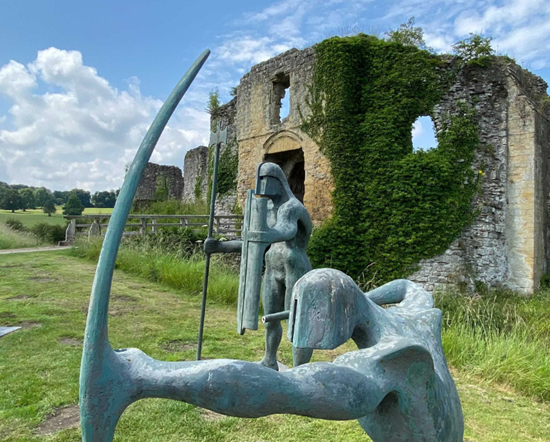
HELMSLEY CASTLE
9 miles from Lastingham Parish
Unlock 900 years of life at Helmsley Castle, an essential site for any visitor to the market town of Helmsley in the North York Moors National Park.
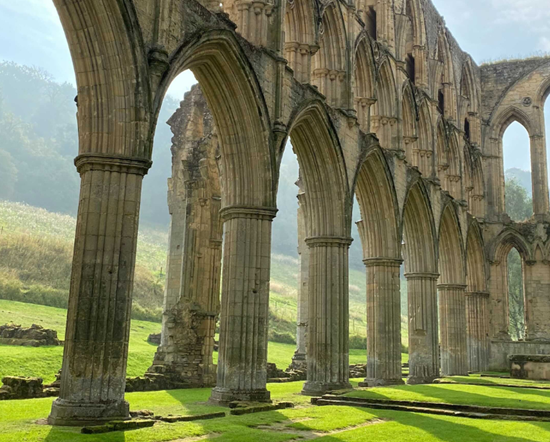
RIEVAULX ABBEY
11 miles from Lastingham Parish
Rievaulx Abbey is the perfect choice for a peaceful day out, with its extensive ruins and fascinating museum in a secluded North York Moors valley.
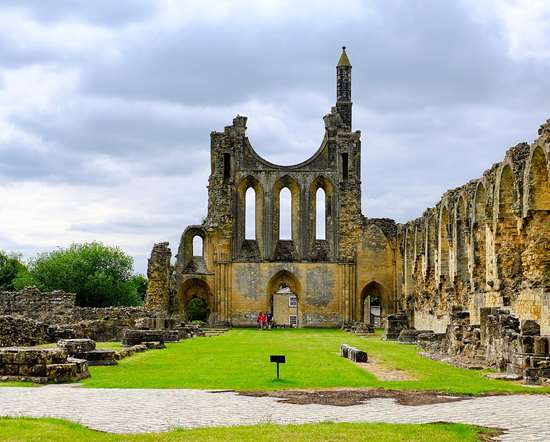
BYLAND ABBEY
14 miles from Lastingham Parish
Once one of the greatest monasteries in England, Byland Abbey inspired the design of church buildings throughout North.
Churches in Lastingham Parish
Crypt church of St Mary

Front Street
Lastingham
York
01751 471495
http://www.lastinghamparishchurch.org.uk
ST MARY LASTINGHAM was founded c.654 as a Celtic monastery by St Cedd of Lindisfarne, a place of prayer and hospitality - which it still is.
Introduction
Lastingham has been a centre of Worship and devotion since the 7th Century. As we welcome you to this ancient and beautiful church, we hope that you will share with us the joyous sense of peace and enjoy the heritage of centauries of Christianity in this church where, in the words of the hymn: "Brothers we are treading where the saints have trod".
History of St. Mary's
Most of the early history of the church comes to us from the Venerable Bede who, in A.D. 731, completed his history of the English Church and People, when he was a monk at the monastery in Jarrow.
The Story of Ct. Cedd and St. Chad founding the Monastery in Lastingham.
"During his episcopate among the east Saxons, God's Servant Cedd often visited his own province of Northumbria to preach. Ethelwald, son of king Oswald, who ruled the province of Deira, Knowing Cedd to be a wise, holy and honourable man, asked him to accept a grant of Land to found a monastery, to which hr himself might often come to pray and hear the word of Go, and where he might be buried: for he firmly believed that the daily prayers of those who would serve God there would be great help to him. The Kings previous chaplain had been Cedd's brother, a priest named Caelin, a man equally devoted to God, who had ministered the word and sacraments to himself and his family, and it was thought of him that the King came to know and love the bishop. In accordance with the King's wishes, Cedd Chose a site for the monastery among some High and remote hills, which seemed more suitable for the dens of robbers and haunts of wild beasts than for human habitation. His purpose in this was to fulfil the prophecy of Isaiah: "in the haunts where dragons once dwelt shall be pasture, with reeds and rushes", and he wished the fruits of good works to spring up where formerly lived only wild beasts, or men who lived like beasts.
The Man of God wished first of all to purify the site of the monastery from the taint of earlier crimes by prayer and fasting, and make it acceptable to God before laying the foundations. He therefore asked the King's permission to remain there throughout the approaching season of Lent, and during this time he fasted until evening every day except Sunday according to custom. Even then he took no food but a morsel of bread, an egg and a little watered milk. he explained that it was the custom of those who had trained him in the rule of regular discipline to dedicate the site of any monastery to God with prayer and fasting. But then days before the end of Lent a messenger arrived to summon him to the King, so that the king's business should not interrupt the work of dedication, Cedd asked his brother Cynebil to complete this holy task. The latter readily consented, and when the period of prayer and fasting came to an end, he built the monastery now called Lastingham, and established there the observances of the usage of Lindisfarne where he had been trained.
When Cedd had been bishop of the province and administered the affairs of the monastery for many years through his chosen representatives, he happened to visit the monastery at the time of plague, and there he fell sick and died. He was first buried in the open, but in the course of time a stone church was built, dedicated to the blessed mother of God, and it is said that his body was re-interred in it on the right side of the altar, although this has never been proven.
The bishop bequeathed the abbacy of the monastery to his brother Chad, who subsequently became a bishop. The four brothers I have mentioned - Cedd, Cynebil, Caelin and Chad - all became famous priests of our Lord, and two became bishops, which is a rare occurrence in one family. When the brethren of Cedd's monastery in the province of the East Saxons heard that their founder had died in the province of Northumbria, about thirty of them came wishing, God willing, either to live near the body of their Father, or to die and be laid to rest at his side. They were welcomed by their brothers and fellow-soldiers of Christ, and all of them died there of the plague with the exception of one little boy who was preserved from death by the prayers of his father Chad.
<span style="font-size: 1rem;">Parish Safeguarding Officer: Maureen Lamey </span>
St Chad
Main Street
Hutton-le-Hole
York
01439 770983
http://www.lastinghamparishchurch.org.uk
St. Chad's Church, Hutton-le-Hole
The village of Hutton-le-Hole is part of the ancient parish of Lastingham, and St Chad’s Church is a daughter church (known as a chapel-of-ease) of St Mary’s at Lastingham. It is under the care of the Vicar and Parochial Church Council of Lastingham.
Records show that at the end of the nineteenth century services were being held in the village schoolroom. In 1901 a disused Congregationalist chapel, known as Zion Chapel, next to the site of the present church, was purchased by the Parish, and this building was dedicated to St Chad. In 1934 this was replaced by the present building, and dedicated once again to St Chad.
Who was St Chad? Chad was one of the three brothers of St Cedd from Lindisfarne who in 654 founded Lastingham Church as a Celtic Monastery. After Cedd’s death in 664, Chad became Abbot of Lastingham. He was later consecrated Bishop of Lichfield. His feast day is 2nd March.
Special features of the building include:
St Gregory

Church Lane
Cropton
York
01439 770983
http://www.lastinghamparishchurch.org.uk
St. Gregory's
The name ‘Cropton’ comes from Anglo-Saxon roots meaning ‘hill-top settlement.’
The village church (since 1986 a fully-fledged parish church) is dedicated to St Gregory the Great. It stands to the east of Castle Hill.
The church was formerly a chapel-of-ease within the Parish of Middleton. In 1986 Cropton with Cawthorne became a new parish, and a member of the new United Benefice of Lastingham with Appleton-le-Moors, Rosedale and Cropton.
There is no record of when the original church was built. The plain circular font is probably Norman, and possibly in the Saxon tradition. A chaplain was attached to the church in the 14th century – perhaps the chaplain to the castle mentioned above.
We know that in the late 18th century the building was slated, after alterations which probably included the addition of a south porch.
In the 1840s the church was severely damaged by fire, and rebuilt between 1844 and 1855. Some of the materials of the original church were re-used, but some were sold off. An apsidal sanctuary was added. A bellcote with two small bells was provided in the west gable.
St Gregory’s continues as a traditional village church.
A full guide to the church is available in the church.
St Mary & St Lawrence
Village Green
Rosedale Abbey
York
01751 471495
http://lastinghamparishchurch.org.uk
The Church of St. Mary and St. Lawrence in Rosedale Abbey
Where is the Abbey?
This is a question many people ask when they come to Rosedale; the abbey doesn’t seem to exist. The truth is that there really was an abbey – or rather a nuns’ priory - and if you were reading this in the church, then you would actually be standing in the area that was the ancient priory chapel.
The Parish Church of St Mary & St Lawrence was built on the foundations of the priory chapel, and if you look carefully you will see signs of the old building.
Walk up to the altar rail, look on the floor on the left, and you will see a memorial tablet inscribed with a cross above which the name MARIA (one of the nuns) is just visible. If you look to the other side of the rail you will see one of the old stone seats from the abbey; this is now the bishop’s chair
What would the Abbey have looked like?
Rosedale Priory was probably founded by William of Rosedale in 1154, under the Benedictine Order. It was never a large community, having about nine nuns in the care of a prioress. It’s possible that small nunneries like Rosedale were a sort of school for the unmarried daughters of the well-to-do.
The only visible ruin of the Abbey itself is the turret in the garden outside the west door of the present church. This turret probably led from the nave of the chapel up to a dormitory. The present school and its playground occupy part of the space on which the cloister would have been.
The Priory was dissolved in 1536. Much of the buildings remained until the mid 19th century, when the expansion of the mining industry meant that there was a great demand for houses. Unfortunately the stone was taken to build the houses that now make up the village, so Rosedale Abbey is the right name, since most of the abbey now forms the present village. Identifiable fragments can be spotted here and there. You can see some window jambs used as gate posts in the lane by the Milburn Arms, and a local builder has shown us a winding stair tread re-used as a roof-coping ‘kneeler’ on a cottage.
The Parish Church
When the valley began to expand in the early nineteenth century, there was a need for a new parish church. In 1839 the old Priory chapel was pulled down and a larger church built on much the same site. The whole cost of £665 was met by public subscription. If you look at the panels on the wall beneath the gallery in the church, you will see recorded every subscription down to the last widow’s mite.
In 1879 the Parish of Rosedale was created, and a vicar appointed. Up until then the west side of Rosedale belonged to Lastingham Parish and the east side to Middleton.
The Present Church
The mines have long since closed, but many people now visit the area. Rosedale has begun to expand again and the church has been renewed and restored.
In the 1970s the sanctuary area has been extended and two side vestries provided. The plaster was taken off the walls to reveal rough but beautiful stone. The floor was replaced and the pews re-positioned to provide a central aisle. These pews were the work of Robert ‘Mouseman’ Thompson of Kilburn and date from his early years before the famous mouse appeared on all his work. The restoration was completed in the 1980s by the placing of a screen to divide the church and create a space at the back which is used for meetings and Sunday school.
In 1984 Rosedale was made part of the United Benefice of Lastingham, which now includes the ecclesiastical parishes of Lastingham, Appleton-le-Moors, Rosedale and Cropton
Pubs in Lastingham Parish
Blacksmith's Arms

Anserdale lane, Lastingham, YO62 6TN
(01751) 417247
blacksmithsarmslastingham.co.uk/
